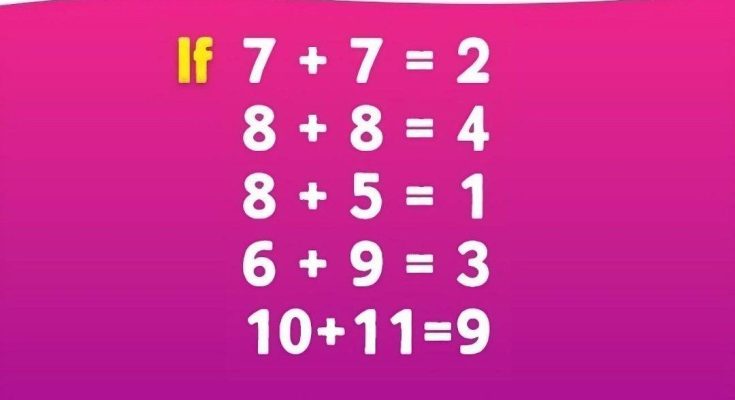Puzzles like these are more than just fun brain teasers—they’re excellent tools for sharpening your logical thinking and analytical skills. At first glance, they seem straightforward, almost deceptively simple. But as you dive in, you’ll quickly realize that the solution requires a creative approach. Let’s break down one such puzzle and uncover the hidden logic behind it.
The Puzzle: What’s the Rule Behind These Equations?

Here’s the set of equations we’re working with:
- 7 + 7 = 2
- 8 + 8 = 4
- 8 + 5 = 1
- 6 + 9 = 3
- 10 + 11 = 9
These equations clearly don’t follow traditional arithmetic rules. So, what’s going on here? The challenge is to figure out the hidden pattern and apply it to solve a new equation:
4 + 9 = ?
Why Puzzles Like These Are Tricky
At first glance, puzzles like this can seem frustrating. Why? Because they intentionally defy the conventional rules we’ve grown accustomed to. Here’s why they’re tougher than they look:
- They challenge standard math assumptions. Most people instinctively try to apply basic arithmetic, but that’s not the key here.
- Details are easy to overlook. The solution often lies in a subtle pattern or rule, hidden in plain sight.
- Logic trumps intuition. It’s tempting to guess the answer, but these puzzles reward methodical reasoning over quick hunches.
- Patterns must be consistent. Even if you think you’ve found the rule, it needs to hold true across all examples—not just one or two.
Breaking It Down: Finding the Hidden Rule
Let’s tackle this puzzle step by step to reveal the logic behind it.
Step 1: Examine the Equations
Here’s the set of equations again:
- 7 + 7 = 2
- 8 + 8 = 4
- 8 + 5 = 1
- 6 + 9 = 3
- 10 + 11 = 9
The first step is to recognize that traditional math doesn’t apply here. These equations are governed by a hidden pattern that connects the inputs (the numbers on the left) to the output (the number on the right).
Step 2: Look for Patterns
To uncover the rule, think creatively about how the numbers might relate. Here’s a useful observation:
The output is the sum of the two numbers minus 12.
Let’s test this theory:
- For 7 + 7 = 2:
7+7=147 + 7 = 147+7=14
Subtract 12 → 14−12=214 – 12 = 214−12=2 - For 8 + 8 = 4:
8+8=168 + 8 = 168+8=16
Subtract 12 → 16−12=416 – 12 = 416−12=4 - For 8 + 5 = 1:
8+5=138 + 5 = 138+5=13
Subtract 12 → 13−12=113 – 12 = 113−12=1 - For 6 + 9 = 3:
6+9=156 + 9 = 156+9=15
Subtract 12 → 15−12=315 – 12 = 315−12=3 - For 10 + 11 = 9:
10+11=2110 + 11 = 2110+11=21
Subtract 12 → 21−12=921 – 12 = 921−12=9
The pattern holds true for all the examples provided!
Step 3: Solve the Final Equation
Now that we’ve identified the rule, let’s apply it to the new equation:
4 + 9 = ?
- Add the two numbers:
4+9=134 + 9 = 134+9=13 - Subtract 12:
13−12=113 – 12 = 113−12=1
Thus, the answer is 1.
What Makes This Puzzle a Great Brain Exercise?
Puzzles like this one push us to think outside the box. They challenge us to break free from conventional frameworks and embrace creative problem-solving. Here’s what makes them such valuable mental workouts:
- Critical Thinking: You’re forced to analyze the problem deeply rather than relying on surface-level assumptions.
- Attention to Detail: Every clue matters, and overlooking even a small hint can lead you astray.
- Logical Reasoning: Puzzles like this require a systematic approach to uncover patterns and test their consistency.
- Flexibility: These challenges teach us to adapt and rethink our strategies when initial attempts don’t work.
How to Approach Puzzles Like This in the Future
If you encounter similar puzzles, keep these tips in mind:
- Forget Standard Rules: Assume the problem operates under a unique set of rules.
- Analyze the Relationships: Look for connections between inputs and outputs. Patterns can be mathematical, visual, or conceptual.
- Test Your Theory: Ensure your solution works for all provided examples—not just one.
- Think Creatively: Be open to unconventional solutions, as the answer often lies in thinking beyond the obvious.
Conclusion: A Simple Rule, A Mind-Bending Puzzle
What seemed like a baffling equation turned out to follow a simple, consistent rule: the sum of the two numbers, minus 12. This puzzle isn’t just a test of math skills—it’s a challenge to your ability to think logically, creatively, and systematically.
Did you solve it before reading the explanation? If not, don’t worry—puzzles like this are meant to stretch your brain. Share this with your friends and see if they can crack the code. And remember, the more you challenge your mind with puzzles, the sharper it becomes!



